Corn Straw as a Solid Carbon Source for the Treatment of Agricultural Drainage Water in Horizontal Subsurface Flow Constructed Wetlands
Abstract
:1. Introduction
2. Materials and Methods
2.1. Pretreatment of Corn Straw
2.2. Carbon Dissolution Test
2.3. Characteristics of the Wastewater
2.4. Wetland Setup and Operation
2.5. Sampling and Analysis
2.6. Statistical Analysis
3. Results and Discussion
3.1. Effect of Pretreatment Methods on the Carbon Source Release of Corn Straw
3.2. Effects of External Carbon Source and HRT on COD Removal
3.3. Effects of External Carbon Source and HRT on Nitrogen Removal
3.4. Effects of External Carbon Source and HRT on Phosphorus Removal
3.5. The Cost Analysis of Different External Carbon Sources
4. Conclusions
Acknowledgments
Author Contributions
Conflicts of Interest
References
- Zhao, J.; Zhao, Y.; Zhao, X.; Jiang, C. Agricultural runoff pollution control by a grassed swales coupled with wetland detention ponds system: A case study in Taihu Basin, China. Environ. Sci. Pollut. Res. 2016, 23, 9093–9104. [Google Scholar] [CrossRef] [PubMed]
- Chang, Y. Nitrogen Removal Efficiency of the Carbon-Sulfur Coupling Surface Flow Constructed Wetland. Master’s Thesis, Chang’an University, Xi’an, China, 2016. [Google Scholar]
- Hua, Y.; Peng, L.; Zhang, S.; Heal, K.V.; Zhao, J.; Zhu, D. Effects of plants and temperature on nitrogen removal and microbiology in pilot-scale horizontal subsurface flow constructed wetlands treating domestic wastewater. Ecol. Eng. 2017, 108, 70–77. [Google Scholar] [CrossRef]
- Chen, Y.; Peng, Y.; Wang, J. Biological phosphorus and nitrogen removal in low C/N ratio domestic sewage treatment by A2/O-BAF combined system. Acta Sci. Circumst. 2010, 30, 1957–1963. [Google Scholar]
- Lee, H.; Han, J.; Yun, Z. Biological nitrogen and phosphorus removal in UCT-type MBR process. Water Sci. Technol. 2009, 59, 2093–2099. [Google Scholar] [CrossRef] [PubMed]
- Gao, J.; Wang, W.; Guo, X.; Zhu, S.; Chen, S.; Zhang, R. Nutrient removal capability and growth characteristics of Iris sibirica in subsurface vertical flow constructed wetlands in winter. Ecol. Eng. 2014, 70, 351–361. [Google Scholar] [CrossRef]
- Jácome, J.A.; Molina, J.; Suárez, J.; Mosqueira, G.; Torres, D. Performance of constructed wetland applied for domestic wastewater treatment: Case study at boimorto (Galicia, Spain). Ecol. Eng. 2016, 95, 324–329. [Google Scholar] [CrossRef]
- Bohórquez, E.; Paredes, D.; Arias, C.A. Vertical flow-constructed wetlands for domestic wastewater treatment under tropical conditions: Effect of different design and operational parameters. Environ. Technol. 2017, 38, 199–208. [Google Scholar] [CrossRef] [PubMed]
- Wu, H.; Fan, J.; Zhang, J.; Ngo, H.H.; Guo, W.; Hu, Z.; Liang, S. Decentralized domestic wastewater treatment using intermittently aerated vertical flow constructed wetlands: Impact of influent strengths. Bioresour. Technol. 2015, 176, 163–168. [Google Scholar] [CrossRef] [PubMed]
- Xu, D.; Li, Y.; Howard, A.; Guan, Y. Effect of earthworm Eisenia fetida and wetland plants on nitrification and denitrification potentials in vertical flow constructed wetland. Chemosphere 2013, 92, 201–206. [Google Scholar] [CrossRef] [PubMed]
- Fu, G.; Huang, S.L.; Guo, Z.; Zhou, Q.; Wu, Z. Effect of plant-based carbon sources on denitrifying microorganisms in a vertical flow constructed wetland. Bioresour. Technol. 2017, 224, 214–221. [Google Scholar] [CrossRef] [PubMed]
- Huett, D.O.; Morris, S.G.; Smith, G.; Hunt, N. Nitrogen and phosphorus removal from plant nursery runoff in vegetated and unvegetated subsurface flow wetlands. Water Res. 2005, 39, 3259–3272. [Google Scholar] [CrossRef] [PubMed]
- Shen, Z.; Zhou, Y.; Liu, J.; Xiao, Y.; Cao, R.; Wu, F. Enhanced removal of nitrate using starch/PCL blends as solid carbon source in a constructed wetland. Bioresour. Technol. 2015, 175, 239–244. [Google Scholar] [CrossRef] [PubMed]
- Li, P.; Zuo, J.; Xing, W.; Tang, L.; Ye, X.; Li, Z. Starch/polyvinyl alcohol blended materials used as solid carbon source for tertiary denitrification of secondary effluent. Environ. Sci. 2013, 25, 1972–1979. [Google Scholar] [CrossRef]
- Wen, Y.; Chen, Y.; Zheng, N.; Yang, D.H.; Zhou, Q. Effects of plant biomass on nitrate removal and transformation of carbon sources in subsurface-flow constructed wetlands. Bioresour. Technol. 2010, 101, 7286–7292. [Google Scholar] [CrossRef] [PubMed]
- Shao, L.; Xu, Z.X.; Jin, W.; Yin, H.L. Rice husk as carbon source and biofilm carrier for water denitrification. Pol. J. Environ. Stud. 2009, 18, 693–699. [Google Scholar] [CrossRef]
- Chen, Y.; Wen, Y.; Zhou, Q.; Vymazal, J. Effects of plant biomass on nitrogen transformation in subsurface-batch constructed wetlands: A stable isotope and mass balance assessment. Water Res. 2014, 63, 158–167. [Google Scholar] [CrossRef] [PubMed]
- Yang, X.L.; Jiang, Q.; Song, H.L.; Gu, T.T.; Xia, M.Q. Selection and application of agricultural wastes as solid carbon sources and biofilm carriers in MBR. J. Hazard. Mater. 2015, 283, 186–192. [Google Scholar] [CrossRef] [PubMed]
- Xu, Z.X.; Shao, L.; Yin, H.L.; Chu, H.Q.; Yao, Y.J. Biological denitrification using corncobs as a carbon source and biofilm carrier. Water Environ. Res. 2009, 81, 242–247. [Google Scholar] [CrossRef] [PubMed]
- Li, G.; Chen, J.; Yang, T.; Sun, J.; Yu, S. Denitrification with corncob as carbon source and biofilm carriers. Water Sci. Technol. 2012, 65, 1238–1243. [Google Scholar] [CrossRef] [PubMed]
- Yao, C.Y. Study on Adding Carbon Source to Strengthen Denitrification in Artificial Wetland. Master’s Thesis, Dongbei University, Shenyang, China, 2014. [Google Scholar]
- Dong, H.Z. Simulation and Regulation of Nitrogen and Phosphorus Pollution in Irrigation Area Based on SWAT Model. Master’s Thesis, Chinese Academic Agricultural Science, Beijing, China, 2011. [Google Scholar]
- Chang, Y.; Wang, T.; Wang, H.; Chu, Z.; Hang, Q.; Liu, K. The long-term nitrogen removal efficiency from agricultural runoff in phragmites Australis packed surface flow constructed wetland. J. Environ. Eng. Technol. 2016, 6, 453–461. [Google Scholar]
- Jun, C.; Lai, C.Y.; Jun, Z.S.; Ping, L.F.; Qun, X.Y. Degradation test of agricultural non-point source pollution in gully and pond wetland. Water Res. Power 2012, 10, 107–109. [Google Scholar]
- Wang, L.L.; Zhao, L.; Tan, X. Influence of different carbon source and ratio of carbon and nitrogen for water denitrification. Environ. Prot. Sci. 2004, 24, 45–47. [Google Scholar]
- Baker, L.A. Design considerations and applications for wetland treatment of high-nitrate waters. Water Sci. Technol. 1998, 38, 389–395. [Google Scholar]
- Chinese State Environmental Protection Administration. Water and Wastewater Monitoring Methods, 4th ed.; Chinese Environmental Science Publishing House: Beijing, China, 2002. [Google Scholar]
- Chen, J.; Wei, X.D.; Liu, Y.S.; Ying, G.G.; Liu, S.S.; He, L.Y.; Yang, Y.Q. Removal of antibiotics and antibiotic resistance genes from domestic sewage by constructed wetlands: Optimization of wetland substrates and hydraulic loading. Sci. Total Environ. 2016, 565, 240–248. [Google Scholar] [CrossRef] [PubMed]
- Li, X.; Jia, Y.; Li, B.; Du, B.; Gao, L. Research on pretreatment methods and carbon releasing property of constructed wetland plant as slow-releasing carbon source. Technol. Water Treat. 2013, 39, 40–46. [Google Scholar]
- Waksman, S.A.; Stevens, K.R. A system of proximate chemical analysis of plant materials. Ind. Eng. Chem. Anal. Ed. 2002, 2, 167–173. [Google Scholar] [CrossRef]
- Braskerud, B.C. Factors affecting nitrogen retention in small constructed wetlands treating agricultural non-point source pollution. Ecol. Eng. 2002, 18, 351–370. [Google Scholar] [CrossRef]
- Song, A.H.; Shen, Z.Q.; Zhou, Y.X.; Liu, S.; Xiao, Y.; Miao, Y. Research on treating dispersed piggery rinse water using rice straw as solid carbon source. Zhongguo Huanjing Kexue/China Environ. Sci. 2015, 35, 2052–2058. [Google Scholar]
- Fang-Ying, J.I.; Yang, Y.G.; Wan, X.J.; Ying, H.E. Effects of carbon source types on operation of denitrifying phosphorus removal system. China Water Wastewater 2010, 26, 5–9. [Google Scholar]
- Xu, J.H.; He, S.B.; Wu, S.Q.; Huang, J.C.; Zhou, W.L.; Chen, X.C. Effects of HRT and water temperature on nitrogen removal in autotrophic gravel filter. Chemosphere 2016, 147, 203–209. [Google Scholar] [CrossRef] [PubMed]
- Boroomandnasab, S. The effects of substrate type, HRT and reed on the lead removal in horizontal subsurface-flow constructed wetland. Desalin. Water Treat. 2015, 56, 3357–3367. [Google Scholar]
- Luo, P.; Liu, F.; Liu, X.; Wu, X.; Yao, R.; Chen, L.; Wu, J. Phosphorus removal from lagoon-pretreated swine wastewater by pilot-scale surface flow constructed wetlands planted with Myriophyllum aquaticum. Sci. Total Environ. 2017, 576, 490–497. [Google Scholar] [CrossRef] [PubMed]
- Pietro, K.C.; Ivanoff, D. Comparison of long-term phosphorus removal performance of two large-scale constructed wetlands in South Florida, USA. Ecol. Eng. 2015, 79, 143–157. [Google Scholar] [CrossRef]
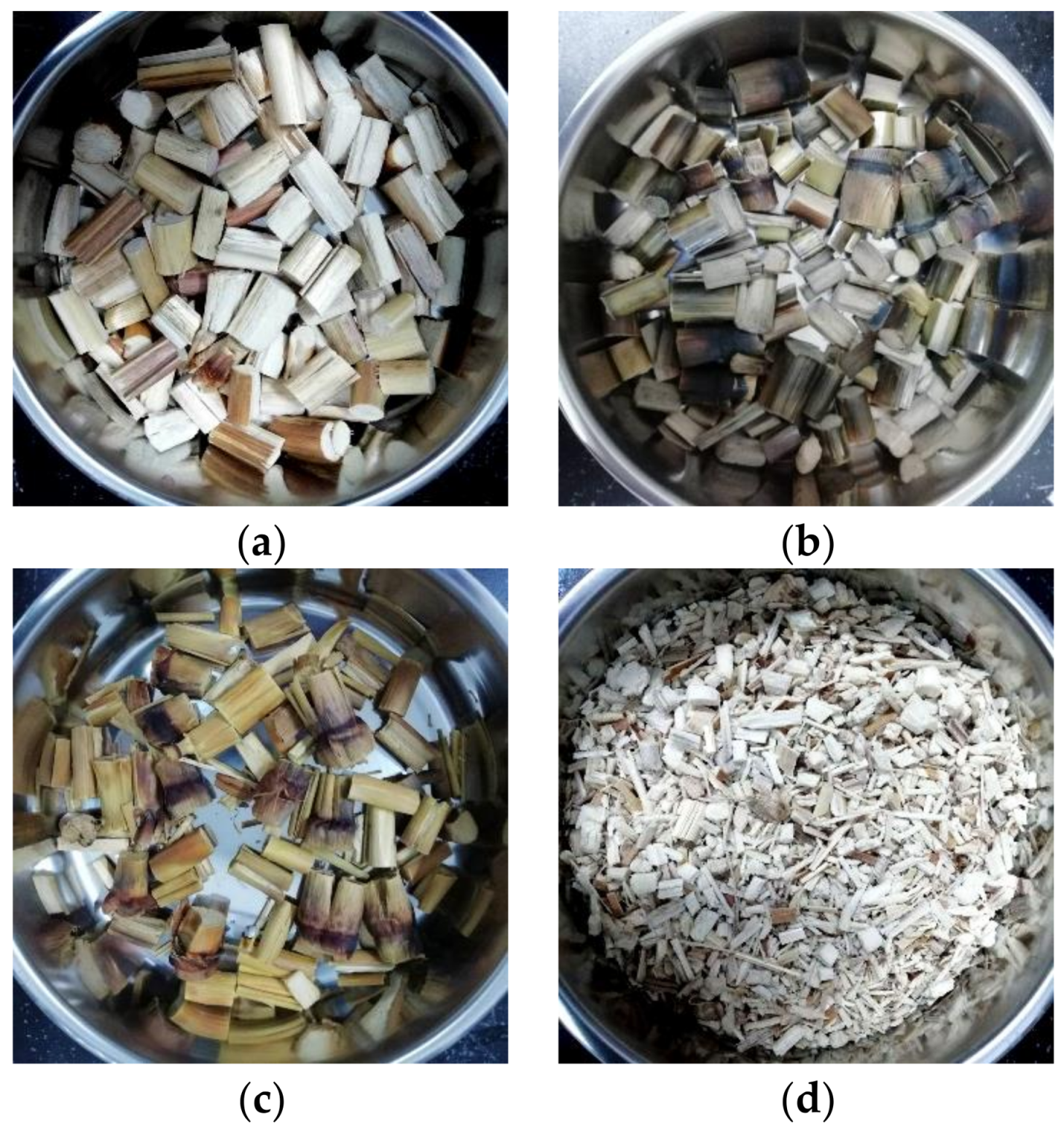
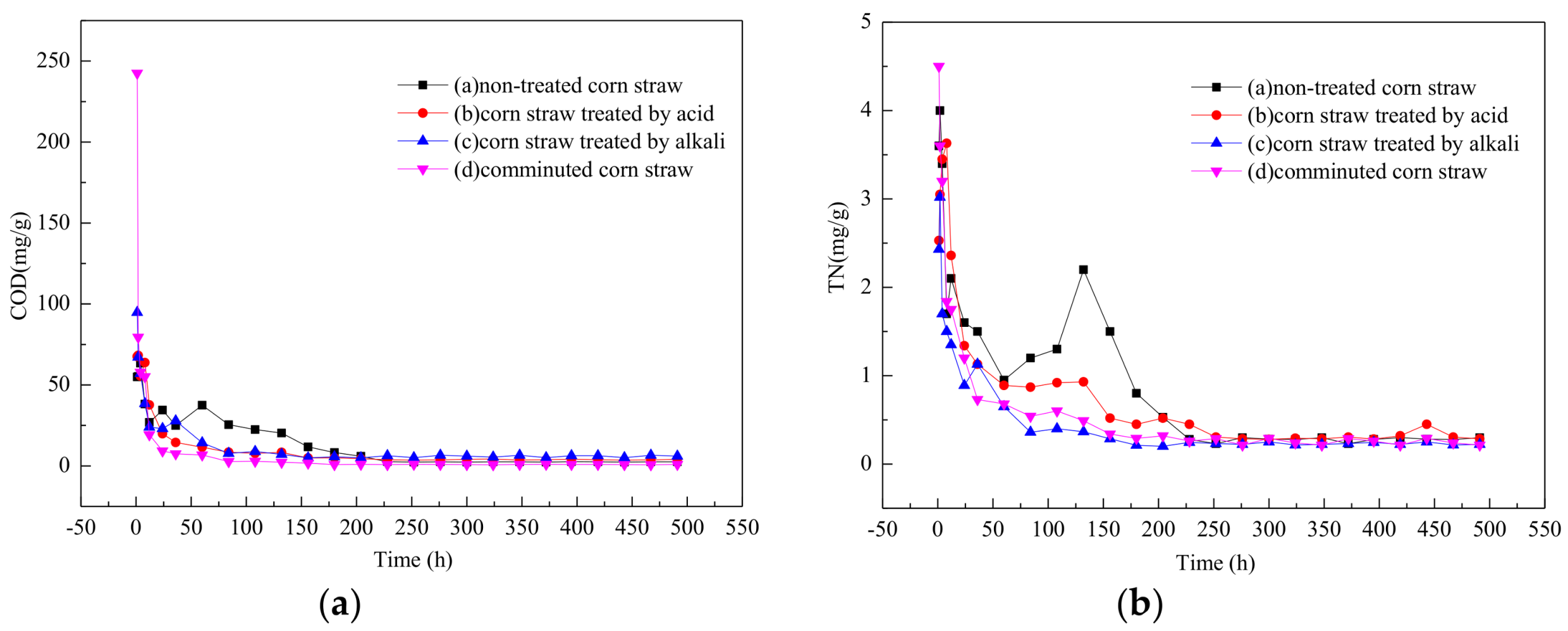
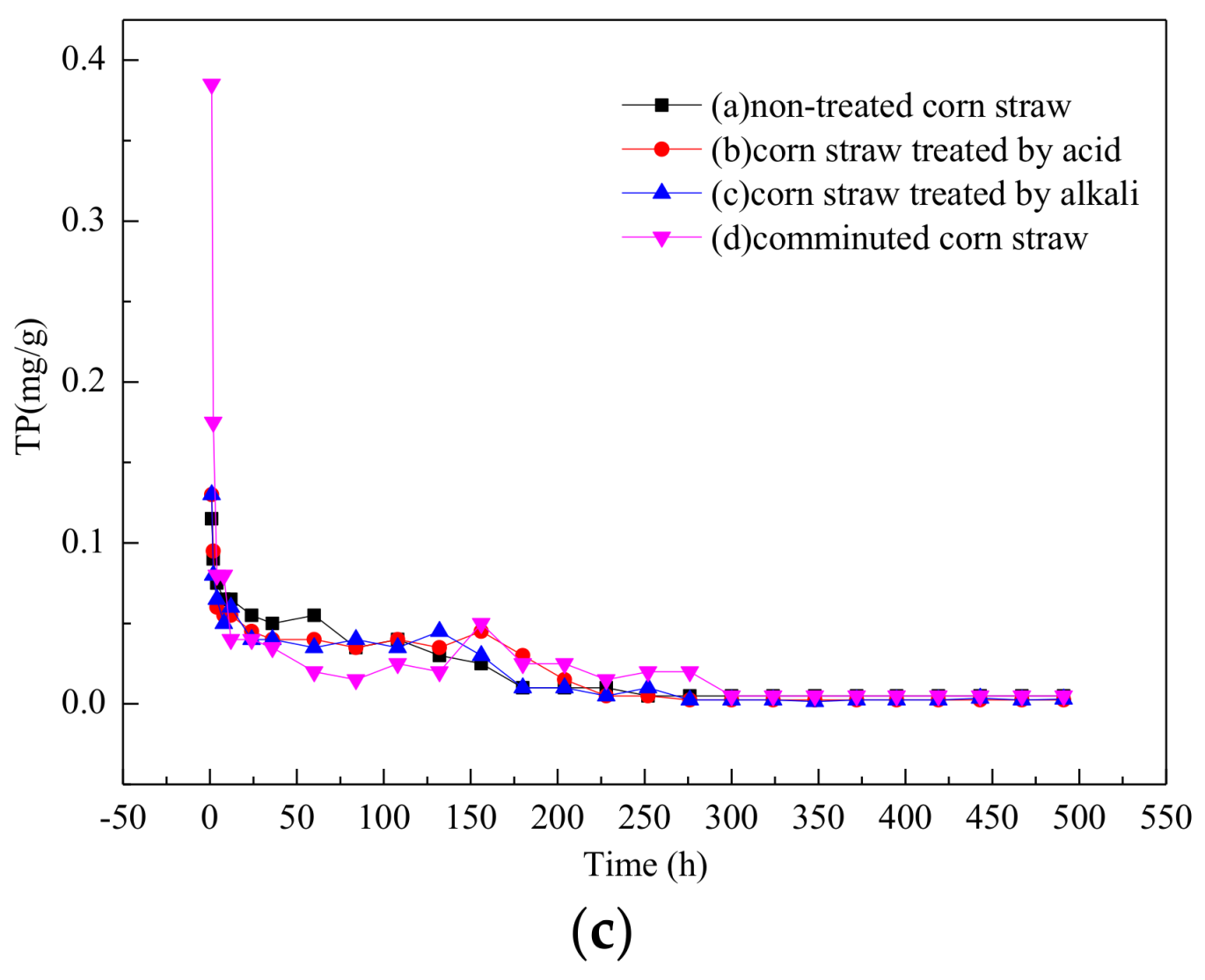
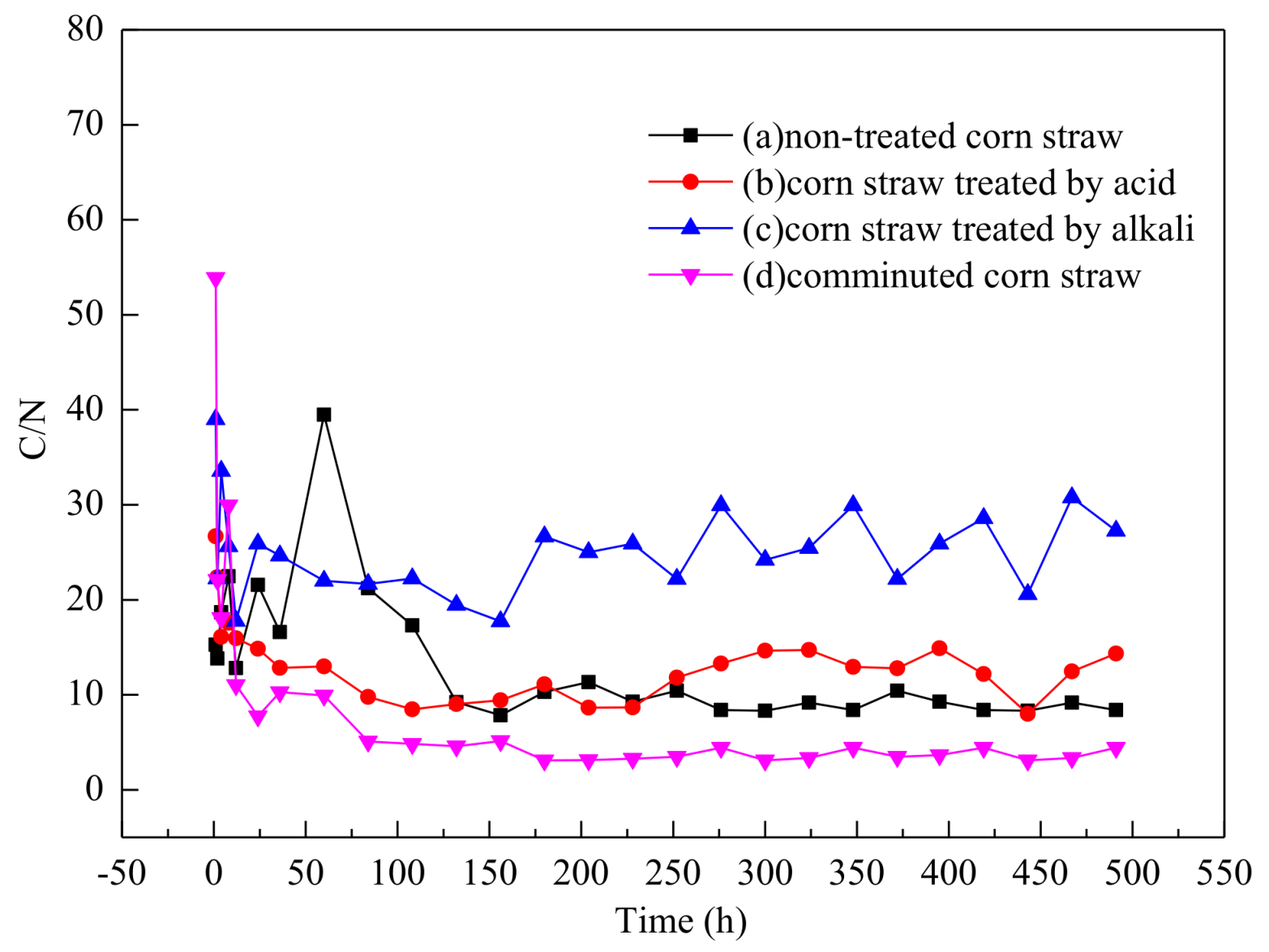
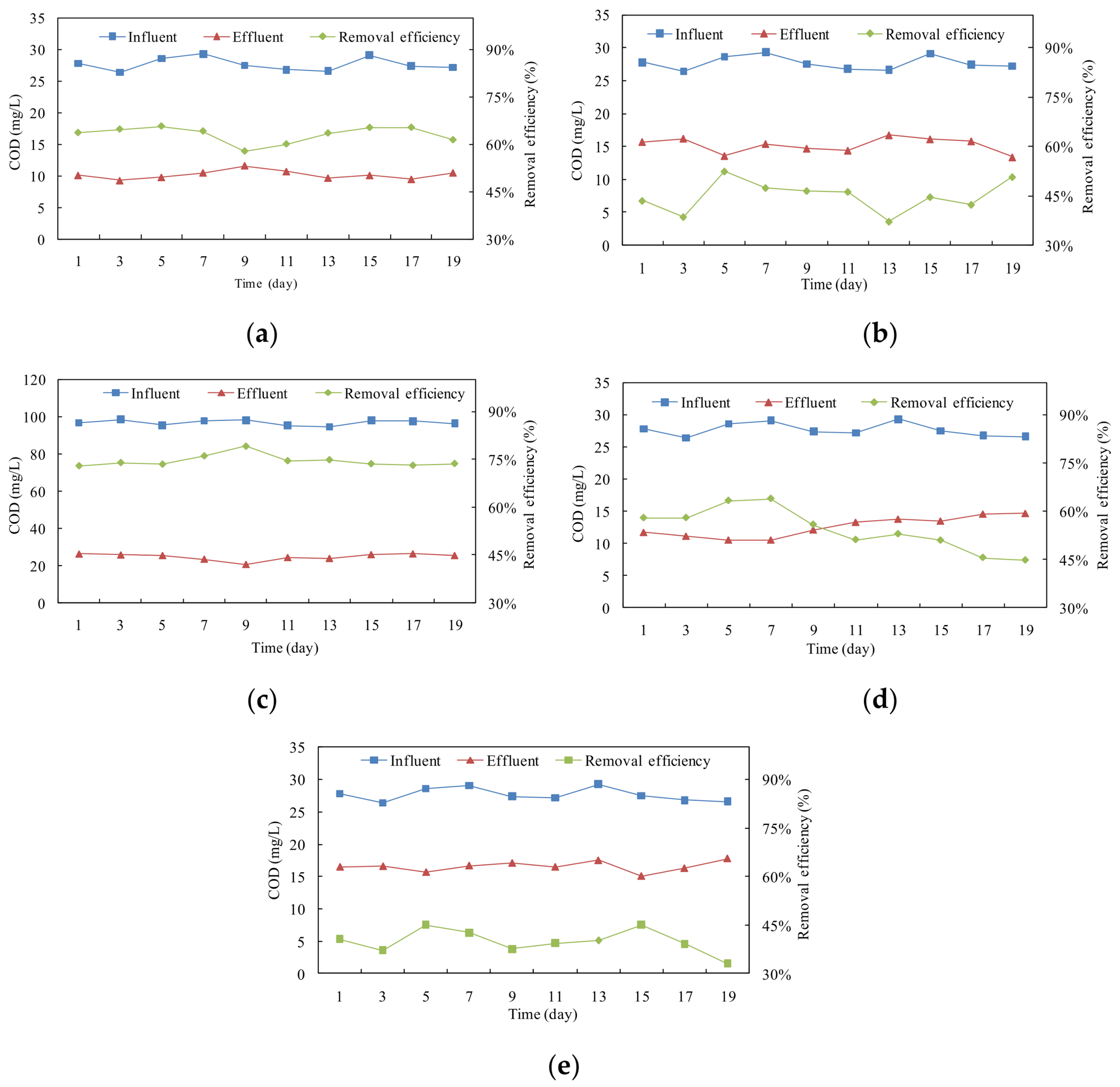



| Reactor | COD | NH4+-N | NO3−-N | TN | TP | ||||||||||
|---|---|---|---|---|---|---|---|---|---|---|---|---|---|---|---|
| Influent Content a (mg/L) | Effluent Content a (mg/L) | Average Removal Efficiency (%) | Influent Content a (mg/L) | Effluent Content a (mg/L) | Average Removal Efficiency (%) | Influent Content a (mg/L) | Effluent Content a (mg/L) | Average Removal Efficiency (%) | Influent Content a (mg/L) | Effluent Content a (mg/L) | Average Removal Efficiency (%) | Influent Content a (mg/L) | Effluent Content a (mg/L) | Average Removal Efficiency (%) | |
| W1 | 27.0 ± 1.0 | 10.0 ± 1.0 | 61.4 | 1.50 ± 0.10 | 0.60 ± 0.15 | 61.4 | 10.5 ± 0.6 | 4.50 ± 0.20 | 57.1 | 12.0 ± 0.5 | 5.80 ± 0.2 | 50.7 | 1.50 ± 0.15 | 0.80 ± 0.10 | 35.4 |
| W2 | 28.0 ± 1.5 | 13.0 ± 1.7 | 54.4 | 1.50 ± 0.25 | 0.50 ± 0.10 | 65.6 | 11.0 ± 0.6 | 4.28 ± 0.13 | 60.0 | 12.0 ± 0.4 | 4.78 ± 0.2 | 53.2 | 1.50 ± 0.15 | 0.75 ± 0.10 | 37.5 |
| W3 | 28.3 ± 1.3 | 12.1 ± 2.1 | 55.6 | 1.55 ± 0.10 | 0.60 ± 0.30 | 58.1 | 10.7 ± 1.0 | 4.07 ± 0.23 | 61.6 | 12.3 ± 1.0 | 4.67 ± 0.3 | 54.4 | 1.55 ± 0.10 | 0.75 ± 0.10 | 38.3 |
| W4 | 27.6 ± 0.8 | 9.1 ± 2.0 | 67.5 | 1.60 ± 0.15 | 0.50 ± 0.05 | 65.3 | 11.0 ± 0.5 | 3.57 ± 0.50 | 68.5 | 12.6 ± 0.5 | 4.07 ± 0.4 | 64.2 | 1.45 ± 0.10 | 0.65 ± 0.10 | 56.7 |
| W5 | 26.6 ± 1.8 | 13.4 ± 1.9 | 48.4 | 1.60 ± 0.10 | 0.80 ± 0.10 | 49.3 | 11.0 ± 0.5 | 5.40 ± 0.40 | 50.1 | 12.6 ± 0.5 | 6.20 ± 0.5 | 36.8 | 1.45 ± 0.10 | 0.95 ± 0.20 | 30.5 |
© 2018 by the authors. Licensee MDPI, Basel, Switzerland. This article is an open access article distributed under the terms and conditions of the Creative Commons Attribution (CC BY) license (http://creativecommons.org/licenses/by/4.0/).
Share and Cite
Li, Y.; Wang, S.; Li, Y.; Kong, F.; Xi, H.; Liu, Y. Corn Straw as a Solid Carbon Source for the Treatment of Agricultural Drainage Water in Horizontal Subsurface Flow Constructed Wetlands. Water 2018, 10, 511. https://doi.org/10.3390/w10040511
Li Y, Wang S, Li Y, Kong F, Xi H, Liu Y. Corn Straw as a Solid Carbon Source for the Treatment of Agricultural Drainage Water in Horizontal Subsurface Flow Constructed Wetlands. Water. 2018; 10(4):511. https://doi.org/10.3390/w10040511
Chicago/Turabian StyleLi, Yuanyuan, Sen Wang, Yue Li, Fanlong Kong, Houye Xi, and Yanan Liu. 2018. "Corn Straw as a Solid Carbon Source for the Treatment of Agricultural Drainage Water in Horizontal Subsurface Flow Constructed Wetlands" Water 10, no. 4: 511. https://doi.org/10.3390/w10040511




